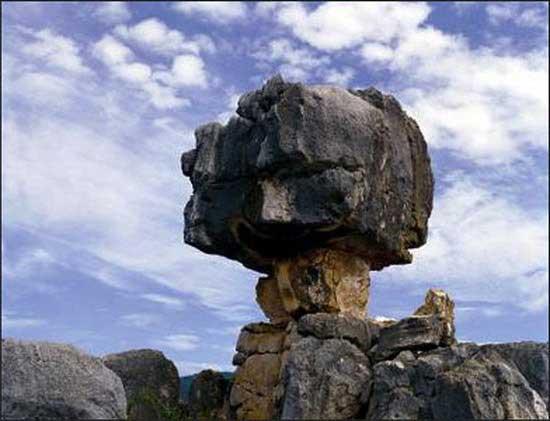
 |
| South China Karst(CNTV) |
Karst means eroded-stone landforms, which usually develop based on carbonate stones such as limestone and dolomite. China’s karst landforms are usually large scale, in various shapes, typical, and have abundant biological and ecological resources.
The Yunnan Stone Forest Scenic Area is located in the Shilin Yi Autonomous County of China’s Yunnan Province and also called the “Lunan Stone Forest.” It is 120 kilometers away from the city of Kunming and covers about 400,000 mu. The stone forest is a typical karst landform which gradually formed over millions of years of geographic transformation. On Feb. 13, 2004, the Yunnan Stone Forest was approved as one of the first batch of world geographic parks by the world geographic park expert evaluation committee of the United Nations Educational, Scientific and Cultural Organization. In 1984, the Stone Forest Scenic Area was approved as one of the first batch of national-level key Scenic and Historic Interest Areas by the State Council. The Stone Forest is also the hometown of Ashima, a beautiful woman of legend from the Yi Nationality. The Yunnan Stone Forest was listed as a world heritage for its large stone forest, small stone forest, and Naigu Stone Forest, as well as its Libo-style sword shape karst, column shape karst and tower shape karst landforms.
The national-level Zhangjiang Scenic and Historic Interest Area is located in Libo County of Guizhou Province, and consists of the Small Seven-Hole Scenic Area, the Large Seven-Hole Scenic Area, the Shuichun River Scenic Area, and the Riverside Scenic Belt along the Zhang River. It covers 271.3 square kilometers. The Riverside Scenic Belt is 30 kilometers long, where the Zhang River goes through the Shuichun River Gorge and the Large and Small Scenic Areas. The peaceful river current, the crystal clear water, the green trees and mountains on both sides of the river and the farms and villages have formed an amazing pastoral picture. The Large and Small Scenic Areas and the Maolan National Nature Reserve have been listed as world heritage as typical cone-shape karst landforms.
The karst scattered in Wulong County of Chongqing consists of three large parts: the Three Natural Bridges, the Jingkou Natural Pit, and the Furong Cave. They contain many stereo landscapes including natural bridges, natural pits, rifts and water-eroded caves. The three large scenic parts are protected as national-level and province-level scenic and historic interest areas individually and as the “Chongqing Wulong Karst National Geographic Park” wholly.


















 Wild Siberian tiger kills cattle in NE China
Wild Siberian tiger kills cattle in NE China


![]()
